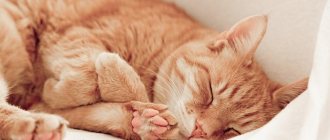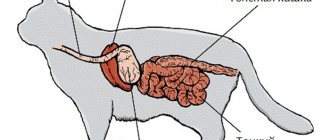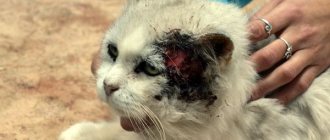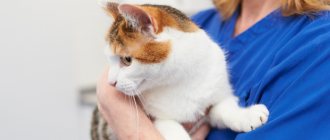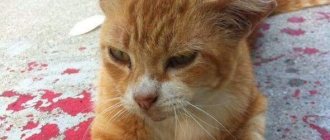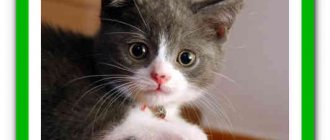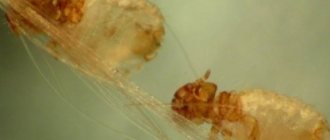If a cat sleeps on its owner’s bed, what is the sign if it sleeps at the feet or above the head? Many cat owners would be interested to know about this. Some say that the animal is simply looking for a warm and comfortable place to sleep, and some say that the cat is capable of taking away negative energy from the owner and therefore lies down exactly where the source of the disease is located.
If a cat sleeps at the head of the owner, what does this mean?
Experts have conducted a number of studies and found that a cat can sleep near its owner's head for several reasons.
The human head is always warm, and therefore the animal is very comfortable there. The location of the cat near another part of the body may indicate that it is hot there and perhaps there is an inflammatory process leading to this. The cat will experience the same comfort when lying on a battery or on a laptop.
In a dream, a person does not swing his head, but a cat has most likely already gotten his foot or hand accidentally, so the animal could remember that he can sleep peacefully near his owner’s head.
An emotional connection between the owner and the cat can occur if they are very attached to each other. Then the location of the cat in the area of the owner’s head indicates that she adores him.
As for human energy, a cat is able to detect the slightest fluctuation. It is for this reason that it will settle down in the place where the most negativity has accumulated. The animal will take on the entire burden of problems (although no - only part of the load, which the cat must then process and then return again for the rest of the negativity).
According to popular belief, the place where the cat lies down is not just that. If the place is always the same, this signals the development of pathology in the area where the cat is located. Constantly settling above the head is a signal of the owner’s chronic fatigue, increased nervousness, frequent headaches and disruptions in cerebral circulation.
Symptoms and diagnosis
In general, the symptoms of ataxia in cats are simple. The pet looks like a drunkard, he shakes, the cat cannot walk normally, in severe cases he falls on his side with a roar, just trying to sit down. A constant tilt of the head to one side, as well as erratic circular eye movements, are very typical. Other symptoms may vary depending on the underlying cause of the ataxia. For example, a cat “under mint” can walk with a wobbling gait with its head held high; from time to time, it shakes it and generously splashes saliva around. It looks terrible, but goes away quickly.
Your veterinarian will perform a complete physical examination of your cat. The information provided by the cat's owner is important. It is advisable to remember the following:
- Did the animal have access to household chemicals, poisons, or was deratization (rodent extermination) carried out in your home or area?
- Is there any information in your pet’s pedigree about any pathologies that the cat’s parents suffered from?
- Did the cat fall from the balcony, did it get hit by a bicycle, etc.
It is very important to remember all the cases of illness that your pet has suffered. It is advisable to tell us if you have tried to treat it yourself by “prescribing” any medications.
A blood test is very important, which will allow you to determine whether there is a deficiency of any important micro- and macroelements and vitamins. X-rays and ultrasound are also used, with the help of which tumors, the presence of parasites, and other serious problems are detected.
The reason for the cat's location in the owner's head can be aromatic and territorial
Oddly enough, cats have their own scent preferences. And if the pet likes the smell of the owner’s new shampoo, he will, without hesitation, lie down right next to her head to enjoy the smell he likes all night long.
Experts say that a cat’s preference for sleeping at the owner’s head should be a signal that it would not hurt to undergo a medical examination. After all, a cat can sense trouble at its very beginning. And if the diagnosis is made on time and treatment is started on time, everything can end quite well.
The cat will climb onto the owner’s chest if it senses his tension or bad mood. The pet will try to calm you down and convey its positive mood.
What diagnostic measures may be required?
During the initial examination, the veterinarian collects a complete history of the animal (symptoms of pathology, the pet’s lifestyle, age, presence and absence of other diseases, etc.). Based on the medical history, the doctor already determines a list of diagnostic measures and tests.
Diagnostics may include:
- MRI of the head;
- urine and blood analysis;
- hearing test;
- X-ray of the head;
- examination of the animal;
- test for nervous system reactions.
Almost all of the above activities are carried out at the first appointment, except for tests.
If a cat sleeps on the owner's bed at his feet, it is a sign
Esotericists claim that all the negativity that comes to a person during the day is concentrated below, which is why most often cats sleep not just anywhere, but precisely at the feet of a person, healing their owner.
There is another opinion on this matter - supposedly purrs see (feel) areas on the human body that need urgent treatment. Thus, problems in the lower extremities cause the cat to sleep there.
Most often, a furry pet is diagnosed with a disease associated with varicose veins in this way. Although simply being tired during the day can lead to a similar state, and the cat will lie down at the feet of its owner for the night.
If a cat sleeps on the owner's bed, whether this is a sign, everyone decides for themselves
There are people who believe in omens, and there are others - ultimately, this is a matter for the owner. Optimists recommend believing only in good omens and not paying attention to others. It may very well be that they are right. After all, suggestion, like self-hypnosis, is a huge power, and therefore it is better to convince yourself that everything in life happens for the better.
The ancient Slavs believed that if you allow a cat to sleep in the same bed with you, then the owners will definitely have frogs in their heads. Nowadays such a statement is unlikely to scare anyone, but before they believed it and drove the fluffies away.
There is a category of people who do not allow cats to sleep with them in bed due to hygiene requirements. But you can monitor the health and cleanliness of the animal as if it were your own. Experts warn about only one thing: those pets that walk outside will always be potentially dangerous.
Cats should not be allowed to sleep with small children either - they may develop an allergy to these animals due to too close contact.
Many of us have noticed that as soon as we get into bed, the cat who had been up to that moment immediately materializes and wants to keep company. The reasons why this independent and narcissistic animal sleeps next to a person, and often on him directly, have mystical and completely material explanations.
What Science Says
A much more logical explanation for such cat behavior from a scientific point of view:
- Felines' body temperatures are slightly higher than humans (2–2.5 °C), so it is more difficult for them to stay warm. Trying to choose a warmer place to sleep, the animal chooses a person, since its temperature is much higher than that of surrounding objects. And the owner’s belly is also soft. It is no coincidence that cats nest near heating appliances in winter, and sometimes simply lie down on the radiators. This explains their healing abilities. Since the diseased organ is often inflamed, its temperature is increased, which cats sense sensitively and move closer to this place. The head, through which the greatest heat transfer occurs, attracts furry, heat-loving pets for the same reason.
Cats use humans as big hot water bottles
Lying on the owner's leg, the cat feels completely safe
Little kittens are soothed by the beating of the human heart
There are a number of scientific studies confirmed by experiments and proving the healing abilities of some representatives of the cat tribe. This is quite possible to believe, since there is treatment with dolphins or horses. This method is called pet therapy, zootherapy or animal therapy.
Our cat loves to sleep in bed, and none of the household members may be there anymore. Apparently, she is attracted to some special smell, because she will not leave until the bedding is removed or a blanket appears. At night she can sleep just next to her, without touching her body, but in close proximity.
Is it acceptable to sleep with a cat?
For a full and quality sleep, you need the maximum level of comfort. A cat trying to snuggle here and there clearly does not contribute to this. And a pet, brazenly lying on its owner, sometimes definitely gets in the way. In addition, cats, although they are extremely clean, carry some infectious diseases (toxoplasmosis) and simply drag dirt on their paws.
Therefore, at least for hygiene reasons, it is better to provide your pet with its own sleeping place. This could be a basket with a soft mattress, a house, a bed, etc. On sale you can even find special heated mats for particularly cold felines.
To prevent the cat from sleeping on its owner, you can purchase a heated mat for it.
If such a tandem is convenient and comfortable for everyone, then there is nothing dangerous in sleeping next to a cat. But you must adhere to some rules:
- The cat needs to be vaccinated promptly.
- Treat against fleas (shampoos, sprays, collars, etc.).
- The animal must be wormed: cats walking on the street - once every 3-4 months;
- domestic cats - 1-2 times a year.
It is highly not recommended to allow cats into the bed of small children.
Sometimes you can’t tell who’s sleeping on whom
Drugs prescribed for stroke
IMPORTANT! Do not self-treat your cat without consulting a veterinarian.
- Cordiamin. Prescribed for administration in the first three days. The drug affects the central nervous system, stimulates the vasomotor and respiratory centers. For cats, the recommended dosage is 0.1-0.12 ml per kilogram of weight. The injection is subcutaneous, but it can also be injected into the muscle. Sulfocamphocaine has a similar effect, but unlike the first drug, it also has an effect on the myocardium. They inject into the muscle twice a day.
- Eufillin. Improves the function of the respiratory muscles, helps enrich the blood with oxygen and reduce carbon dioxide levels. Subcutaneous administration at a dosage of 0.1-0.2 ml per kilogram of weight.
- No-shpa - tablets or injections. Once a day. Relieves spasms.
- Gamavit is a multivitamin complex.
- Thiotriazolin. Helps normalize lipid, protein and carbohydrate metabolism. Affects the liver and gallbladder, restores hepatocytes and activates the antioxidant system. If the cat weighs less than three kilograms, then a dosage of 1/4 of the tablet or 0.5 ml intramuscularly is adequate. If the weight is over 3 kg, then half a tablet or 1 ml/kg is prescribed. Reception - twice a day.
- Neuromidin (1.5%). The action is aimed at improving memory, accelerating the conduction of impulses along nerve fibers and increasing the contractility of smooth muscle organs. For cats weighing up to 5 kg, the dosage is 0.2 ml. Injects once into the muscle.
- Piracetam. Improves blood supply to the brain. Single injection, 0.5-1 ml.
- Furosemide. Anti-edema. 0.5-1 ml/kg intramuscularly or subcutaneously is sufficient.
- Glucose (5%). Helps supply the body with the energy necessary for the functioning of organs, enhances metabolic processes and dilates blood vessels, promotes the outflow of fluid and enhances the liver’s ability to cleanse the blood of toxins. 15-20 ml once a day is enough.
- Cerucal. Anti-vomiting. Dosage per 10 kg of animal weight - 0.3-0.7 ml. Administration is allowed up to three times during the day.
All treatment and dosage must be prescribed by the doctor individually, based on the results of the tests performed. Therapy should be carried out immediately and also aimed at eliminating the cause. If after three days of treatment no dynamics are observed, the prognosis is disappointing.
The cat may be in the hospital for three to five days. This will allow you to adjust the treatment if necessary.
What does the desire of cats to sleep on a person mean: popular beliefs and opinions of scientists
Since ancient times, cats have been credited with unusual origins and properties; these animals were treated with reverence and even idolized. Nowadays, furry animals also enjoy constant love among both children and adults.
Cats love to sleep with people, and there are many reasons for this.
Despite their wayward and independent nature, domestic cats will never refuse to purr on their owner’s lap or stomach. And it also happens that a pet regularly climbs into bed with someone in the household and spends the night next to him.
There are many explanations for this predilection of tailed pets - from superstitious speculation to scientifically proven opinions.
If a cat lies down on the owner’s stomach and falls asleep there, this most often indicates the animal’s desire to warm up. And the pet chooses a warmer place for such purposes. And the human body is also good because you can comfortably fit on it.
In addition, representatives of the cat family are famous for their ability to sense a person’s bad mood and stressed state. It is believed that sleeping a pet on its stomach in the solar plexus area can cure depression and blues.
It is worth mentioning separately the superstitions associated with pregnancy. It has long been believed that a cat sits on a woman’s stomach and kneads it with its paws if a new life is born inside the expectant mother.
During my first pregnancy, my Siamese spent the entire pregnancy with me, either on her stomach or, if I slept on my side, directly next to my stomach (slept in a spoon position). As a result, I slept through the first contractions at night with her))) I woke up to the fact that my water had already broken))) apparently, thanks to the cat, I practically did not feel any particularly unpleasant sensations from childbirth. While I washed and got ready, I arrived at the maternity hospital and almost immediately gave birth)))
Margarita, Moscow
My cat generally lies down modestly at his feet at night, and in the morning I wake up at his feet! ...but he's such a sweetheart that we can't chase him...
y_GE-GE_na
Cats' favorite place to sleep is at their owner's feet.
If a cat continually strives to sit on the owner’s chest and fall asleep, you should think about the animal’s psychological comfort. After all, the beating of a human heart reminds an adult pet of childhood and communication with its mother, whom for some reason the animal began to miss.
MarMusIzya
This may be due to the owner's frequent departures, long lonely hours when he is away from home, or insufficient attention from household members to the cat. In order to compensate for the lack of kindness and affection, to calm down and feel confident, the animal climbs onto the person’s chest, and then falls asleep to the rhythmic heartbeat of its beloved creature in warmth and comfort.
The reason for the cat laying on the owner's chest may be the pet's sad mood.
The cat suddenly climbed onto her head, had difficulty positioning herself there and began to purr - a sign of an incipient cerebral vasospasm, which after a while results in migraines against the background of changing atmospheric pressure.
From a scientific point of view, this behavior of the animal is explained from two positions, complementary to each other:
- cats by nature are predators, accustomed to keeping the situation in the captured territory under control. For these purposes, the most convenient places for viewing are the crowns of trees, the roofs of houses, and in apartment conditions - doors, cabinets and... the owner’s head;
- In addition to the desire to rule the house and its inhabitants, cats can thus manifest insecurity and various phobias. The higher the animal climbs, the safer it feels.
Cats love to sleep next to children because they are an inexhaustible source of heat.
So, most often, cats’ love for spending time lying on their beloved owner or other household member is associated with the animal’s mood or the state of human health.
The most common (as confirmed by the experience of the owners) remain the following versions of such interesting behavior of cats:
- Finding a comfortable and soft place to sleep. It is worth mentioning here that a cat’s body temperature is 3 degrees higher than that of a human. Because of this, it can be very difficult for animals to stay warm. Therefore, pets can often be found basking on a sunny windowsill, behind radiators or under the owner’s blanket;
- In order for the animal to feel calm and safe, it settles as close to the owner as possible, sometimes even lying on the face. In this way, the cat ensures itself the most relaxed state and quality rest;
- loving and gentle representatives of the feline family prefer to first mash the area they like on the owner’s body, and then lie down and fall asleep with a clear conscience. Even if the animal is independent, the furry animal is very loyal to its owner. Such attachment is expressed in the desire to sleep next to the person;
- The smell of the owner and the aromas in the house attract cats just as much as a soft bed. If your pet likes the smell of perfume or shampoo on his hair, the cat will not miss the opportunity to be on the owner’s head and properly lick the hair. This also explains the love of tailed animals to spend time resting next to sleeping children. After all, babies always smell like mother and warm milk;
- the desire to help the owner cope with negative mood and various diseases. The most controversial reason, according to zoologists, for cats falling asleep on the human body. However, this version has supporters among ordinary owners of furry purrs.
Causes of stroke
Hemorrhagic stroke in cats (with hemorrhage) occurs due to the following factors:
- traumatic brain injury of varying severity.
- vascular inflammation.
- a brain tumor.
- ingestion of poison or toxins into the blood.
- poisoning with severe vomiting.
- prolonged high body temperature due to an infectious disease.
- severe stress.
- excess weight and associated vascular fragility.
- high blood pressure.
- microstroke.
Causes of ischemic stroke:
- cardiovascular diseases.
- impaired kidney function.
- movement of worm larvae through the blood.
- thyroid diseases.
- inappropriate use of hormonal drugs.
- blood clots
- diabetes.
It happens that the veterinarian cannot determine the cause of the stroke. In this case, it will recur with a 99.9% probability - since the provoking factor has not been eliminated. Cats cannot withstand a repeated attack.
Do cats really heal people by lying on them?
What stands out is the ability of cats to relieve pain and stabilize human health.
All kinds of cats are needed, all kinds of cats are important!
There is no consensus among scientists on this matter. Most zoologists do not find confirmation of popular beliefs about the special impact of furry friends on human diseases. However, there are scientists who see undoubted benefits for human health in communicating with a cat.
Research conducted by the National University of Therapeutic Influences of Great Britain has confirmed the rumors associated with the healing influence of representatives of the cat family on humans. Thus, it was found that the tailed pets produce a magnetic field comparable in strength to the radiation of medical equipment. Thanks to this property, during long-term communication between a person and his pet, the animal owner’s immunity is strengthened and the risk of developing heart attacks and strokes is reduced.
American scientists also conducted an experiment involving ten thousand volunteers. During the study, zoologists revealed the direct influence of communication with cats on the high life expectancy of purring owners in almost 70% of cases.
It may very well be that popular beliefs about the healing abilities of cats have a basis
The purring of a cat also has undoubted benefits, especially when a person and an animal are sleeping or resting together. Because vibrations from sounds made by a cat at a frequency of up to 45 hertz are similar to ultrasonic effects. Thus, the pet heals both itself and its owner. Indeed, under the influence of low-frequency purring, the healing of damage to the skin and even bones is stimulated. This is confirmed by the scientific observations of bioacoustics specialist Dr. Elisabeth Muchentaller.
It turns out that old wives' tales about cats contain a grain of truth. The purring of cats truly has healing powers.
E. Muchentaller
Perhaps the most obvious is the ability of cats to provide warmth from their body and thereby help keep the owner warm during a cold or sore throat. In addition, when a person strokes a pet, a natural electrostatic voltage is formed between them, which has a beneficial effect on the healing process.
